Evaluating Reading Theories, Strategies, and the Australian Curriculum
VerifiedAdded on 2020/10/23
|10
|3040
|379
Essay
AI Summary
This essay critically reflects on reading theories and their application within the Australian English Curriculum, focusing on early reading development. It begins with an introduction that defines critical reflection and its importance in understanding the curriculum. The main body of the essay critically analyzes key reading theories, including Schema theory, the Traditional bottom-up view, and the Meta Cognitive View Theory, discussing their principles and implications. The essay then explores the application of these theories to the content of the Australian Curriculum English, highlighting how they can be used to enhance students' reading skills. Furthermore, it critically evaluates various approaches and strategies used to teach reading in the early years, such as activating prior knowledge and using word walls, as well as text comprehension strategies. Finally, the essay offers a critical reflection on the appropriateness of the selected reading theories for teaching early reading development, summarizing the key findings and their relevance to effective teaching practices. The essay emphasizes the importance of understanding and applying these theories to improve reading abilities among learners.
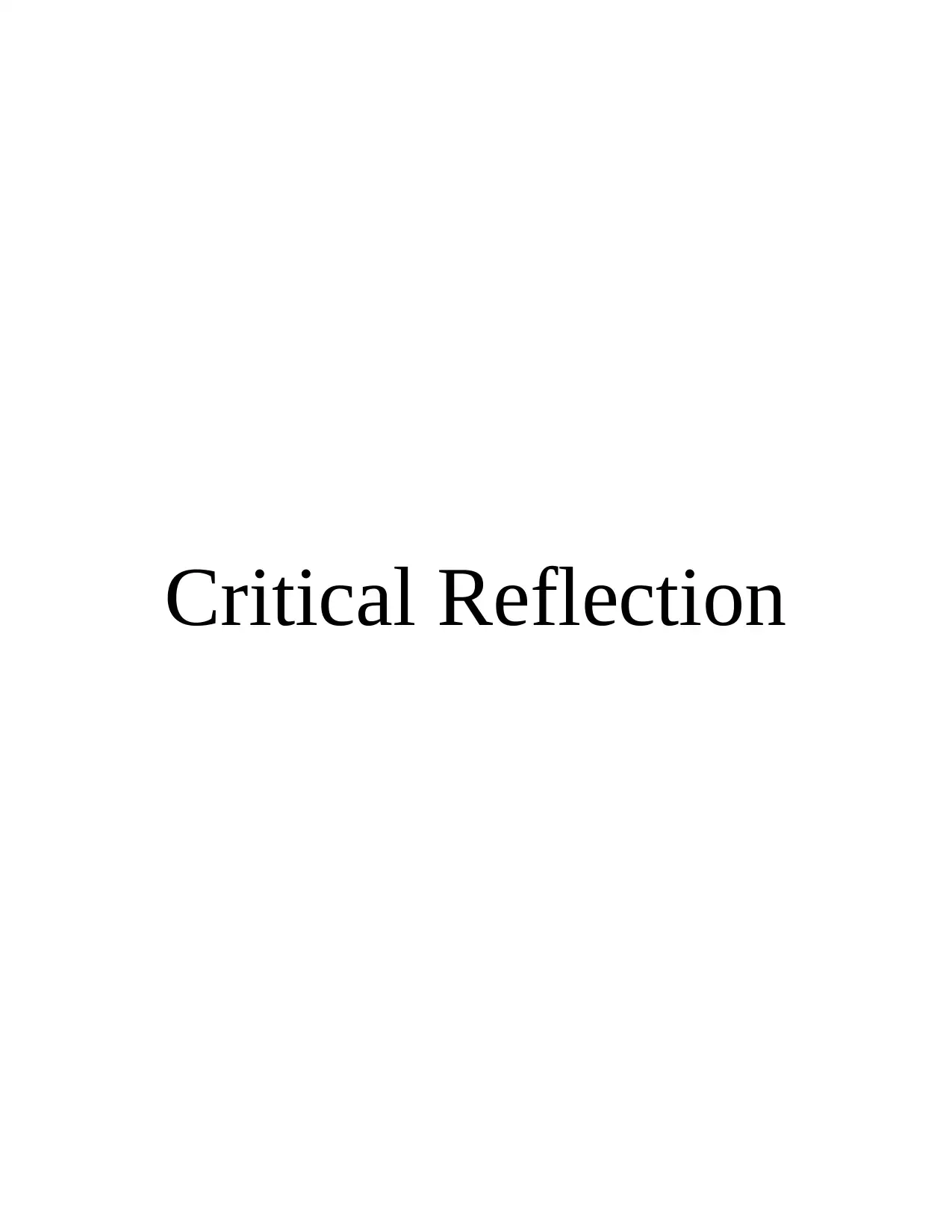
Critical Reflection
Paraphrase This Document
Need a fresh take? Get an instant paraphrase of this document with our AI Paraphraser
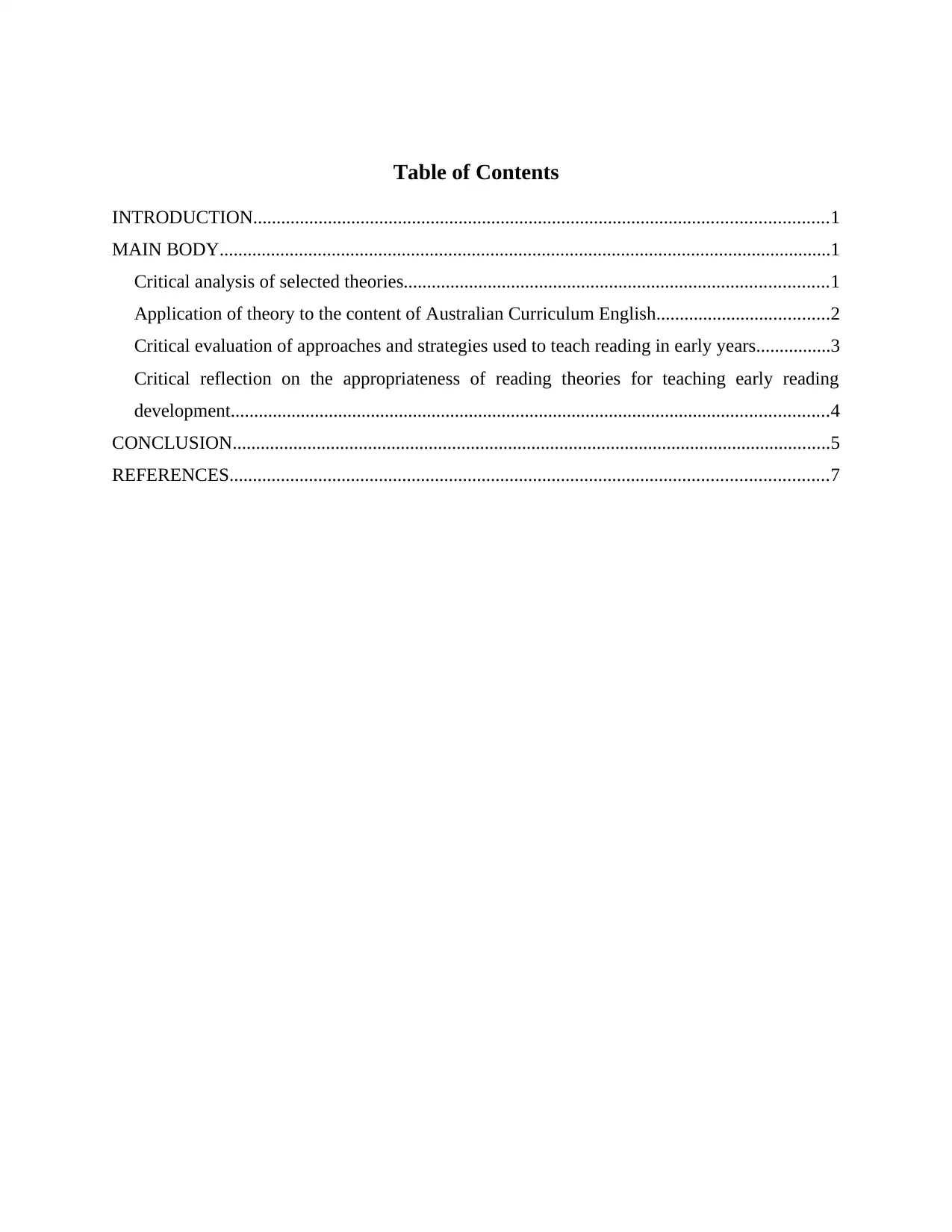
Table of Contents
INTRODUCTION...........................................................................................................................1
MAIN BODY...................................................................................................................................1
Critical analysis of selected theories...........................................................................................1
Application of theory to the content of Australian Curriculum English.....................................2
Critical evaluation of approaches and strategies used to teach reading in early years................3
Critical reflection on the appropriateness of reading theories for teaching early reading
development................................................................................................................................4
CONCLUSION................................................................................................................................5
REFERENCES................................................................................................................................7
INTRODUCTION...........................................................................................................................1
MAIN BODY...................................................................................................................................1
Critical analysis of selected theories...........................................................................................1
Application of theory to the content of Australian Curriculum English.....................................2
Critical evaluation of approaches and strategies used to teach reading in early years................3
Critical reflection on the appropriateness of reading theories for teaching early reading
development................................................................................................................................4
CONCLUSION................................................................................................................................5
REFERENCES................................................................................................................................7

INTRODUCTION
Critical reflection refers to a reasoning process that support in forming up meamning of
an experience. It can be reflective, analytical and descriptive that can be articulate in several
ways like oral, written or in artistic expression. This report is about Australian English
Curriculum which is a coursework that includes several activities which support a child to
improve its reading as well as spoken skill. It includes reading, writing, listening, spoken and
other related activities. This report consists of two reading theories that help in developing skills
of students at their primary stage. In addition to this it also includes the application of theories
over the content of Australian Curriculum English. Apart from this it also involve the evaluation
of approaches and strategies that are used to teach reading in early years. At last it involve a
description about the appropriateness of selected reading theories for teaching early reading
development.
MAIN BODY
Critical analysis of selected theories
There are number of theories related to reading that help in developing the reading ability
among learners that support them in enhancing their knowledge. Some of the commonly known
reading theories are explained below:
Schema theory:
As per the view point of Kyrsha Seymour (2019), Schema theory is an explanation of
ways in which reader uses prior knowledge to learn new things from presented text. This theory
work over fundamental principle that written text doesn't carry meaning by itself rather it provide
direction to reader so that they can retrieve meaning from their previously gained knowledge.
According to Jeff Pankin (2013), Schema theory is defined as a branch of cognitive
science which describes how a brain structure and use knowledge to learn new things. It is
basically an organised unit of knowledge for an event or particular subject. Schema get
developed and changes with the new experience or information which further supports in
enhancement of knowledge. It guides how a person interpret new information which is also have
an great influence over their understanding and performance.
1
Critical reflection refers to a reasoning process that support in forming up meamning of
an experience. It can be reflective, analytical and descriptive that can be articulate in several
ways like oral, written or in artistic expression. This report is about Australian English
Curriculum which is a coursework that includes several activities which support a child to
improve its reading as well as spoken skill. It includes reading, writing, listening, spoken and
other related activities. This report consists of two reading theories that help in developing skills
of students at their primary stage. In addition to this it also includes the application of theories
over the content of Australian Curriculum English. Apart from this it also involve the evaluation
of approaches and strategies that are used to teach reading in early years. At last it involve a
description about the appropriateness of selected reading theories for teaching early reading
development.
MAIN BODY
Critical analysis of selected theories
There are number of theories related to reading that help in developing the reading ability
among learners that support them in enhancing their knowledge. Some of the commonly known
reading theories are explained below:
Schema theory:
As per the view point of Kyrsha Seymour (2019), Schema theory is an explanation of
ways in which reader uses prior knowledge to learn new things from presented text. This theory
work over fundamental principle that written text doesn't carry meaning by itself rather it provide
direction to reader so that they can retrieve meaning from their previously gained knowledge.
According to Jeff Pankin (2013), Schema theory is defined as a branch of cognitive
science which describes how a brain structure and use knowledge to learn new things. It is
basically an organised unit of knowledge for an event or particular subject. Schema get
developed and changes with the new experience or information which further supports in
enhancement of knowledge. It guides how a person interpret new information which is also have
an great influence over their understanding and performance.
1
⊘ This is a preview!⊘
Do you want full access?
Subscribe today to unlock all pages.

Trusted by 1+ million students worldwide
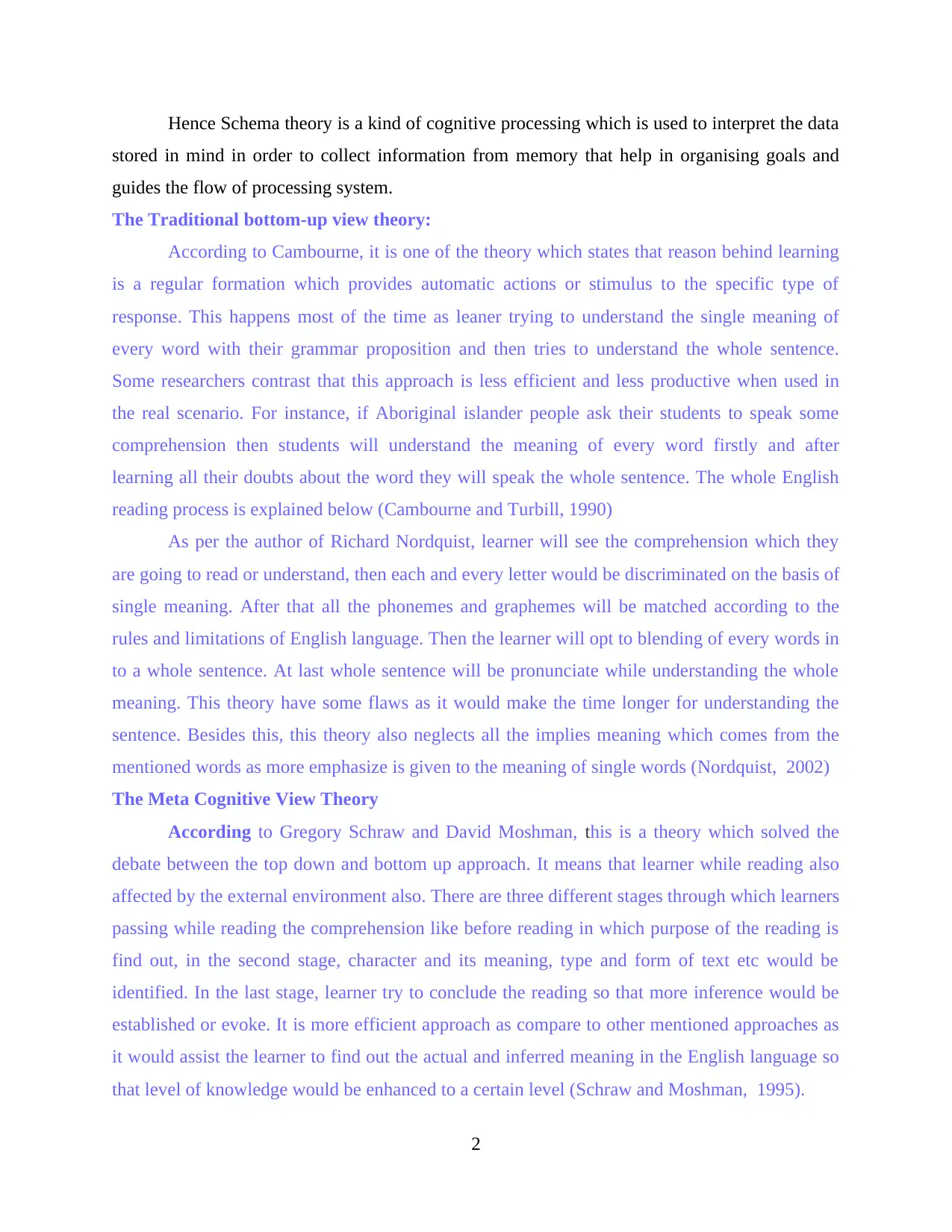
Hence Schema theory is a kind of cognitive processing which is used to interpret the data
stored in mind in order to collect information from memory that help in organising goals and
guides the flow of processing system.
The Traditional bottom-up view theory:
According to Cambourne, it is one of the theory which states that reason behind learning
is a regular formation which provides automatic actions or stimulus to the specific type of
response. This happens most of the time as leaner trying to understand the single meaning of
every word with their grammar proposition and then tries to understand the whole sentence.
Some researchers contrast that this approach is less efficient and less productive when used in
the real scenario. For instance, if Aboriginal islander people ask their students to speak some
comprehension then students will understand the meaning of every word firstly and after
learning all their doubts about the word they will speak the whole sentence. The whole English
reading process is explained below (Cambourne and Turbill, 1990)
As per the author of Richard Nordquist, learner will see the comprehension which they
are going to read or understand, then each and every letter would be discriminated on the basis of
single meaning. After that all the phonemes and graphemes will be matched according to the
rules and limitations of English language. Then the learner will opt to blending of every words in
to a whole sentence. At last whole sentence will be pronunciate while understanding the whole
meaning. This theory have some flaws as it would make the time longer for understanding the
sentence. Besides this, this theory also neglects all the implies meaning which comes from the
mentioned words as more emphasize is given to the meaning of single words (Nordquist, 2002)
The Meta Cognitive View Theory
According to Gregory Schraw and David Moshman, this is a theory which solved the
debate between the top down and bottom up approach. It means that learner while reading also
affected by the external environment also. There are three different stages through which learners
passing while reading the comprehension like before reading in which purpose of the reading is
find out, in the second stage, character and its meaning, type and form of text etc would be
identified. In the last stage, learner try to conclude the reading so that more inference would be
established or evoke. It is more efficient approach as compare to other mentioned approaches as
it would assist the learner to find out the actual and inferred meaning in the English language so
that level of knowledge would be enhanced to a certain level (Schraw and Moshman, 1995).
2
stored in mind in order to collect information from memory that help in organising goals and
guides the flow of processing system.
The Traditional bottom-up view theory:
According to Cambourne, it is one of the theory which states that reason behind learning
is a regular formation which provides automatic actions or stimulus to the specific type of
response. This happens most of the time as leaner trying to understand the single meaning of
every word with their grammar proposition and then tries to understand the whole sentence.
Some researchers contrast that this approach is less efficient and less productive when used in
the real scenario. For instance, if Aboriginal islander people ask their students to speak some
comprehension then students will understand the meaning of every word firstly and after
learning all their doubts about the word they will speak the whole sentence. The whole English
reading process is explained below (Cambourne and Turbill, 1990)
As per the author of Richard Nordquist, learner will see the comprehension which they
are going to read or understand, then each and every letter would be discriminated on the basis of
single meaning. After that all the phonemes and graphemes will be matched according to the
rules and limitations of English language. Then the learner will opt to blending of every words in
to a whole sentence. At last whole sentence will be pronunciate while understanding the whole
meaning. This theory have some flaws as it would make the time longer for understanding the
sentence. Besides this, this theory also neglects all the implies meaning which comes from the
mentioned words as more emphasize is given to the meaning of single words (Nordquist, 2002)
The Meta Cognitive View Theory
According to Gregory Schraw and David Moshman, this is a theory which solved the
debate between the top down and bottom up approach. It means that learner while reading also
affected by the external environment also. There are three different stages through which learners
passing while reading the comprehension like before reading in which purpose of the reading is
find out, in the second stage, character and its meaning, type and form of text etc would be
identified. In the last stage, learner try to conclude the reading so that more inference would be
established or evoke. It is more efficient approach as compare to other mentioned approaches as
it would assist the learner to find out the actual and inferred meaning in the English language so
that level of knowledge would be enhanced to a certain level (Schraw and Moshman, 1995).
2
Paraphrase This Document
Need a fresh take? Get an instant paraphrase of this document with our AI Paraphraser
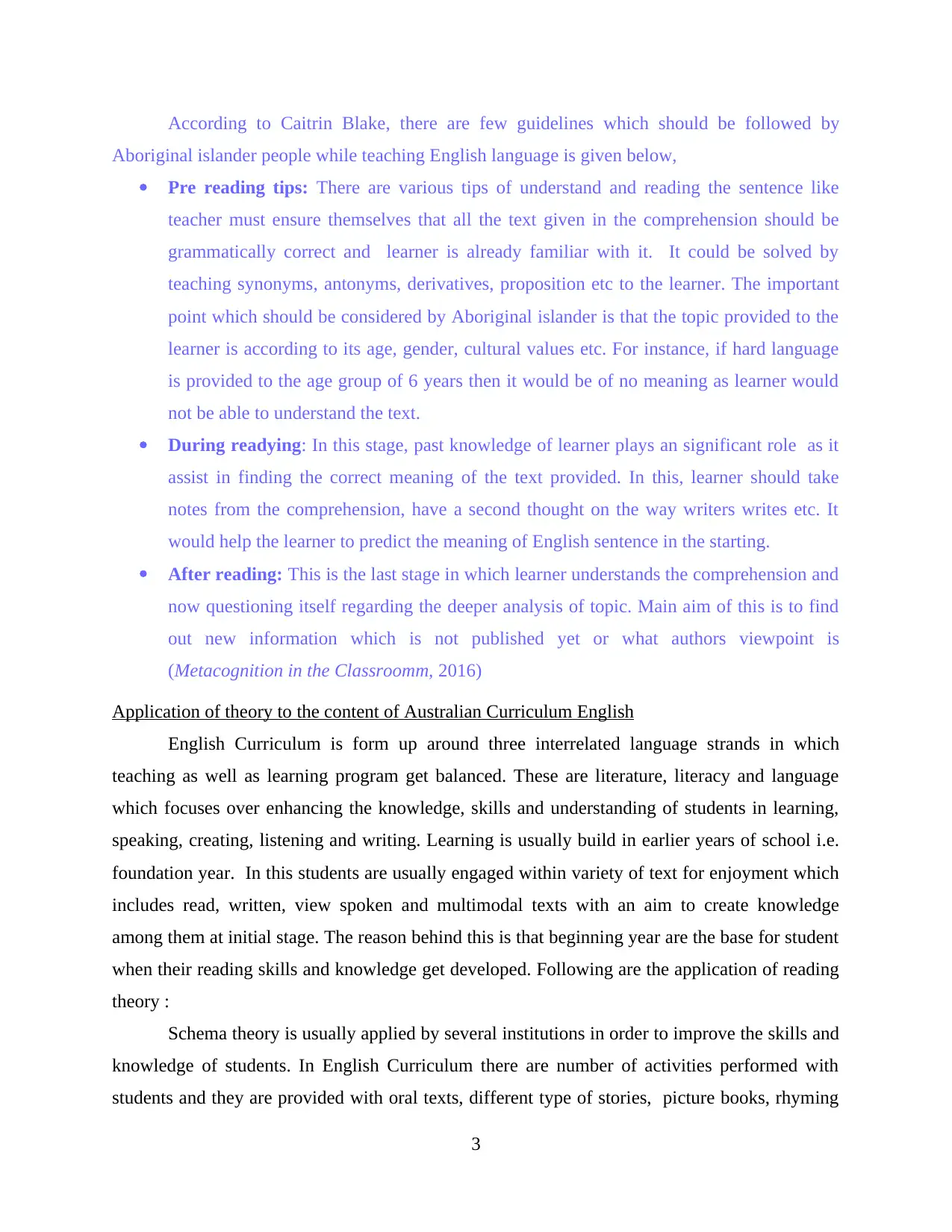
According to Caitrin Blake, there are few guidelines which should be followed by
Aboriginal islander people while teaching English language is given below,
Pre reading tips: There are various tips of understand and reading the sentence like
teacher must ensure themselves that all the text given in the comprehension should be
grammatically correct and learner is already familiar with it. It could be solved by
teaching synonyms, antonyms, derivatives, proposition etc to the learner. The important
point which should be considered by Aboriginal islander is that the topic provided to the
learner is according to its age, gender, cultural values etc. For instance, if hard language
is provided to the age group of 6 years then it would be of no meaning as learner would
not be able to understand the text.
During readying: In this stage, past knowledge of learner plays an significant role as it
assist in finding the correct meaning of the text provided. In this, learner should take
notes from the comprehension, have a second thought on the way writers writes etc. It
would help the learner to predict the meaning of English sentence in the starting.
After reading: This is the last stage in which learner understands the comprehension and
now questioning itself regarding the deeper analysis of topic. Main aim of this is to find
out new information which is not published yet or what authors viewpoint is
(Metacognition in the Classroomm, 2016)
Application of theory to the content of Australian Curriculum English
English Curriculum is form up around three interrelated language strands in which
teaching as well as learning program get balanced. These are literature, literacy and language
which focuses over enhancing the knowledge, skills and understanding of students in learning,
speaking, creating, listening and writing. Learning is usually build in earlier years of school i.e.
foundation year. In this students are usually engaged within variety of text for enjoyment which
includes read, written, view spoken and multimodal texts with an aim to create knowledge
among them at initial stage. The reason behind this is that beginning year are the base for student
when their reading skills and knowledge get developed. Following are the application of reading
theory :
Schema theory is usually applied by several institutions in order to improve the skills and
knowledge of students. In English Curriculum there are number of activities performed with
students and they are provided with oral texts, different type of stories, picture books, rhyming
3
Aboriginal islander people while teaching English language is given below,
Pre reading tips: There are various tips of understand and reading the sentence like
teacher must ensure themselves that all the text given in the comprehension should be
grammatically correct and learner is already familiar with it. It could be solved by
teaching synonyms, antonyms, derivatives, proposition etc to the learner. The important
point which should be considered by Aboriginal islander is that the topic provided to the
learner is according to its age, gender, cultural values etc. For instance, if hard language
is provided to the age group of 6 years then it would be of no meaning as learner would
not be able to understand the text.
During readying: In this stage, past knowledge of learner plays an significant role as it
assist in finding the correct meaning of the text provided. In this, learner should take
notes from the comprehension, have a second thought on the way writers writes etc. It
would help the learner to predict the meaning of English sentence in the starting.
After reading: This is the last stage in which learner understands the comprehension and
now questioning itself regarding the deeper analysis of topic. Main aim of this is to find
out new information which is not published yet or what authors viewpoint is
(Metacognition in the Classroomm, 2016)
Application of theory to the content of Australian Curriculum English
English Curriculum is form up around three interrelated language strands in which
teaching as well as learning program get balanced. These are literature, literacy and language
which focuses over enhancing the knowledge, skills and understanding of students in learning,
speaking, creating, listening and writing. Learning is usually build in earlier years of school i.e.
foundation year. In this students are usually engaged within variety of text for enjoyment which
includes read, written, view spoken and multimodal texts with an aim to create knowledge
among them at initial stage. The reason behind this is that beginning year are the base for student
when their reading skills and knowledge get developed. Following are the application of reading
theory :
Schema theory is usually applied by several institutions in order to improve the skills and
knowledge of students. In English Curriculum there are number of activities performed with
students and they are provided with oral texts, different type of stories, picture books, rhyming
3
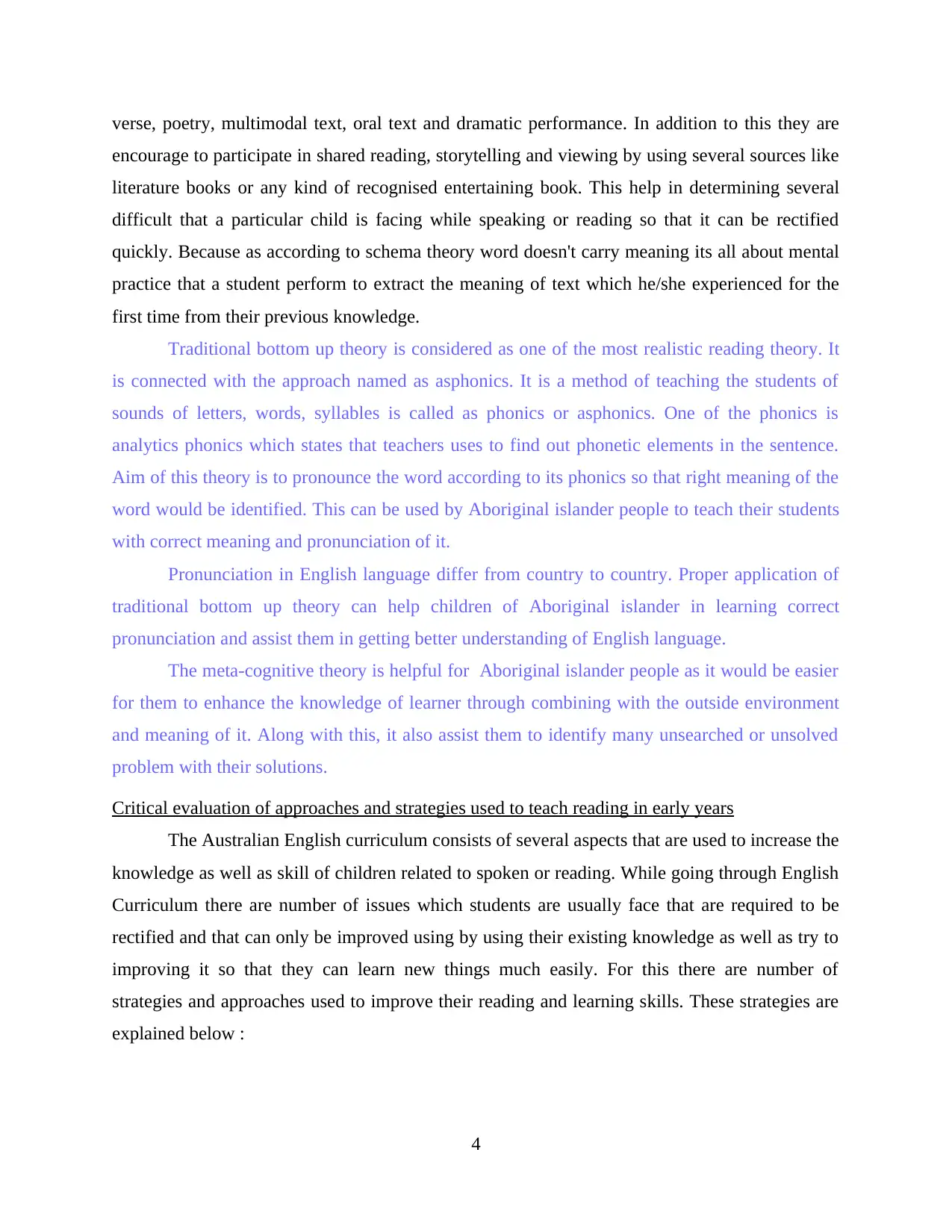
verse, poetry, multimodal text, oral text and dramatic performance. In addition to this they are
encourage to participate in shared reading, storytelling and viewing by using several sources like
literature books or any kind of recognised entertaining book. This help in determining several
difficult that a particular child is facing while speaking or reading so that it can be rectified
quickly. Because as according to schema theory word doesn't carry meaning its all about mental
practice that a student perform to extract the meaning of text which he/she experienced for the
first time from their previous knowledge.
Traditional bottom up theory is considered as one of the most realistic reading theory. It
is connected with the approach named as asphonics. It is a method of teaching the students of
sounds of letters, words, syllables is called as phonics or asphonics. One of the phonics is
analytics phonics which states that teachers uses to find out phonetic elements in the sentence.
Aim of this theory is to pronounce the word according to its phonics so that right meaning of the
word would be identified. This can be used by Aboriginal islander people to teach their students
with correct meaning and pronunciation of it.
Pronunciation in English language differ from country to country. Proper application of
traditional bottom up theory can help children of Aboriginal islander in learning correct
pronunciation and assist them in getting better understanding of English language.
The meta-cognitive theory is helpful for Aboriginal islander people as it would be easier
for them to enhance the knowledge of learner through combining with the outside environment
and meaning of it. Along with this, it also assist them to identify many unsearched or unsolved
problem with their solutions.
Critical evaluation of approaches and strategies used to teach reading in early years
The Australian English curriculum consists of several aspects that are used to increase the
knowledge as well as skill of children related to spoken or reading. While going through English
Curriculum there are number of issues which students are usually face that are required to be
rectified and that can only be improved using by using their existing knowledge as well as try to
improving it so that they can learn new things much easily. For this there are number of
strategies and approaches used to improve their reading and learning skills. These strategies are
explained below :
4
encourage to participate in shared reading, storytelling and viewing by using several sources like
literature books or any kind of recognised entertaining book. This help in determining several
difficult that a particular child is facing while speaking or reading so that it can be rectified
quickly. Because as according to schema theory word doesn't carry meaning its all about mental
practice that a student perform to extract the meaning of text which he/she experienced for the
first time from their previous knowledge.
Traditional bottom up theory is considered as one of the most realistic reading theory. It
is connected with the approach named as asphonics. It is a method of teaching the students of
sounds of letters, words, syllables is called as phonics or asphonics. One of the phonics is
analytics phonics which states that teachers uses to find out phonetic elements in the sentence.
Aim of this theory is to pronounce the word according to its phonics so that right meaning of the
word would be identified. This can be used by Aboriginal islander people to teach their students
with correct meaning and pronunciation of it.
Pronunciation in English language differ from country to country. Proper application of
traditional bottom up theory can help children of Aboriginal islander in learning correct
pronunciation and assist them in getting better understanding of English language.
The meta-cognitive theory is helpful for Aboriginal islander people as it would be easier
for them to enhance the knowledge of learner through combining with the outside environment
and meaning of it. Along with this, it also assist them to identify many unsearched or unsolved
problem with their solutions.
Critical evaluation of approaches and strategies used to teach reading in early years
The Australian English curriculum consists of several aspects that are used to increase the
knowledge as well as skill of children related to spoken or reading. While going through English
Curriculum there are number of issues which students are usually face that are required to be
rectified and that can only be improved using by using their existing knowledge as well as try to
improving it so that they can learn new things much easily. For this there are number of
strategies and approaches used to improve their reading and learning skills. These strategies are
explained below :
4
⊘ This is a preview!⊘
Do you want full access?
Subscribe today to unlock all pages.

Trusted by 1+ million students worldwide
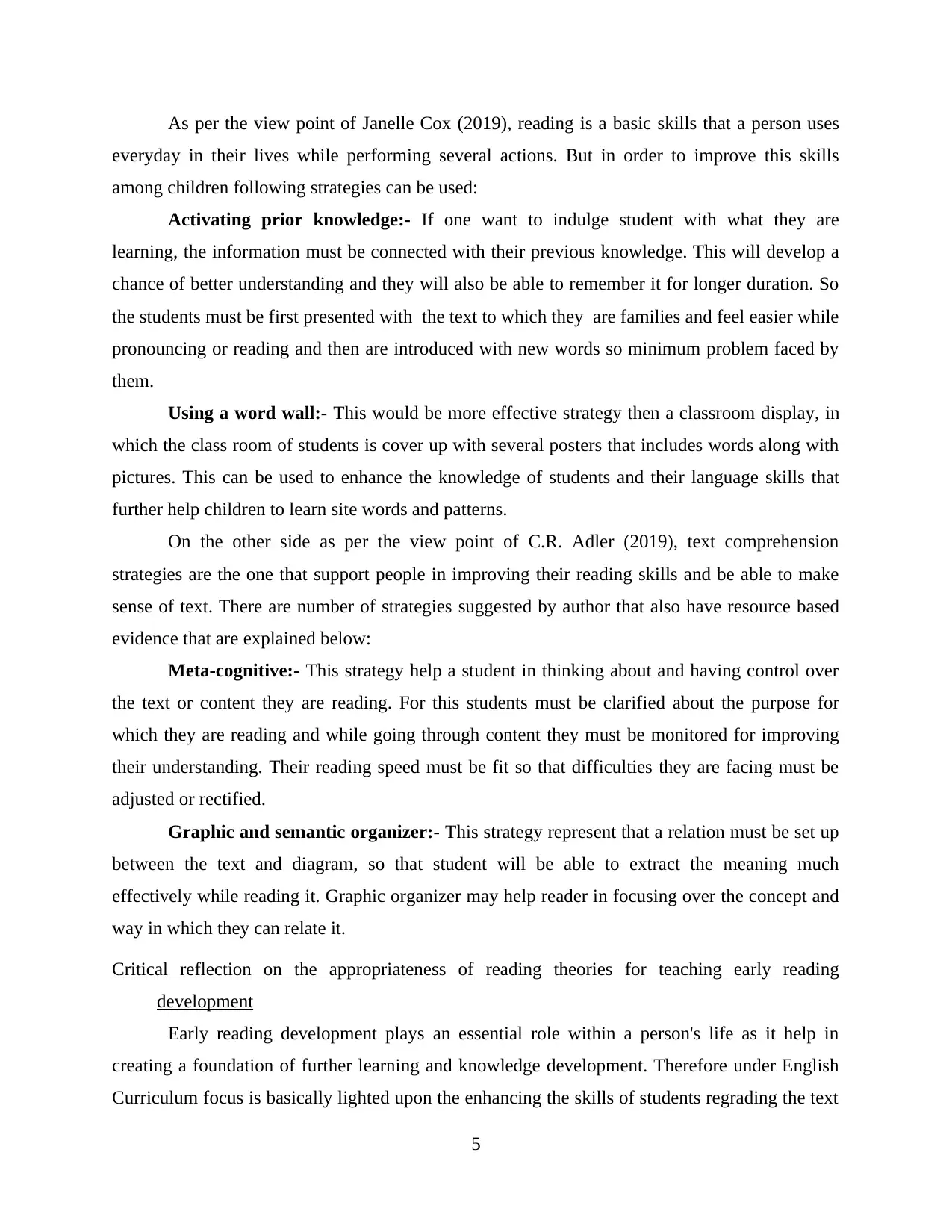
As per the view point of Janelle Cox (2019), reading is a basic skills that a person uses
everyday in their lives while performing several actions. But in order to improve this skills
among children following strategies can be used:
Activating prior knowledge:- If one want to indulge student with what they are
learning, the information must be connected with their previous knowledge. This will develop a
chance of better understanding and they will also be able to remember it for longer duration. So
the students must be first presented with the text to which they are families and feel easier while
pronouncing or reading and then are introduced with new words so minimum problem faced by
them.
Using a word wall:- This would be more effective strategy then a classroom display, in
which the class room of students is cover up with several posters that includes words along with
pictures. This can be used to enhance the knowledge of students and their language skills that
further help children to learn site words and patterns.
On the other side as per the view point of C.R. Adler (2019), text comprehension
strategies are the one that support people in improving their reading skills and be able to make
sense of text. There are number of strategies suggested by author that also have resource based
evidence that are explained below:
Meta-cognitive:- This strategy help a student in thinking about and having control over
the text or content they are reading. For this students must be clarified about the purpose for
which they are reading and while going through content they must be monitored for improving
their understanding. Their reading speed must be fit so that difficulties they are facing must be
adjusted or rectified.
Graphic and semantic organizer:- This strategy represent that a relation must be set up
between the text and diagram, so that student will be able to extract the meaning much
effectively while reading it. Graphic organizer may help reader in focusing over the concept and
way in which they can relate it.
Critical reflection on the appropriateness of reading theories for teaching early reading
development
Early reading development plays an essential role within a person's life as it help in
creating a foundation of further learning and knowledge development. Therefore under English
Curriculum focus is basically lighted upon the enhancing the skills of students regrading the text
5
everyday in their lives while performing several actions. But in order to improve this skills
among children following strategies can be used:
Activating prior knowledge:- If one want to indulge student with what they are
learning, the information must be connected with their previous knowledge. This will develop a
chance of better understanding and they will also be able to remember it for longer duration. So
the students must be first presented with the text to which they are families and feel easier while
pronouncing or reading and then are introduced with new words so minimum problem faced by
them.
Using a word wall:- This would be more effective strategy then a classroom display, in
which the class room of students is cover up with several posters that includes words along with
pictures. This can be used to enhance the knowledge of students and their language skills that
further help children to learn site words and patterns.
On the other side as per the view point of C.R. Adler (2019), text comprehension
strategies are the one that support people in improving their reading skills and be able to make
sense of text. There are number of strategies suggested by author that also have resource based
evidence that are explained below:
Meta-cognitive:- This strategy help a student in thinking about and having control over
the text or content they are reading. For this students must be clarified about the purpose for
which they are reading and while going through content they must be monitored for improving
their understanding. Their reading speed must be fit so that difficulties they are facing must be
adjusted or rectified.
Graphic and semantic organizer:- This strategy represent that a relation must be set up
between the text and diagram, so that student will be able to extract the meaning much
effectively while reading it. Graphic organizer may help reader in focusing over the concept and
way in which they can relate it.
Critical reflection on the appropriateness of reading theories for teaching early reading
development
Early reading development plays an essential role within a person's life as it help in
creating a foundation of further learning and knowledge development. Therefore under English
Curriculum focus is basically lighted upon the enhancing the skills of students regrading the text
5
Paraphrase This Document
Need a fresh take? Get an instant paraphrase of this document with our AI Paraphraser
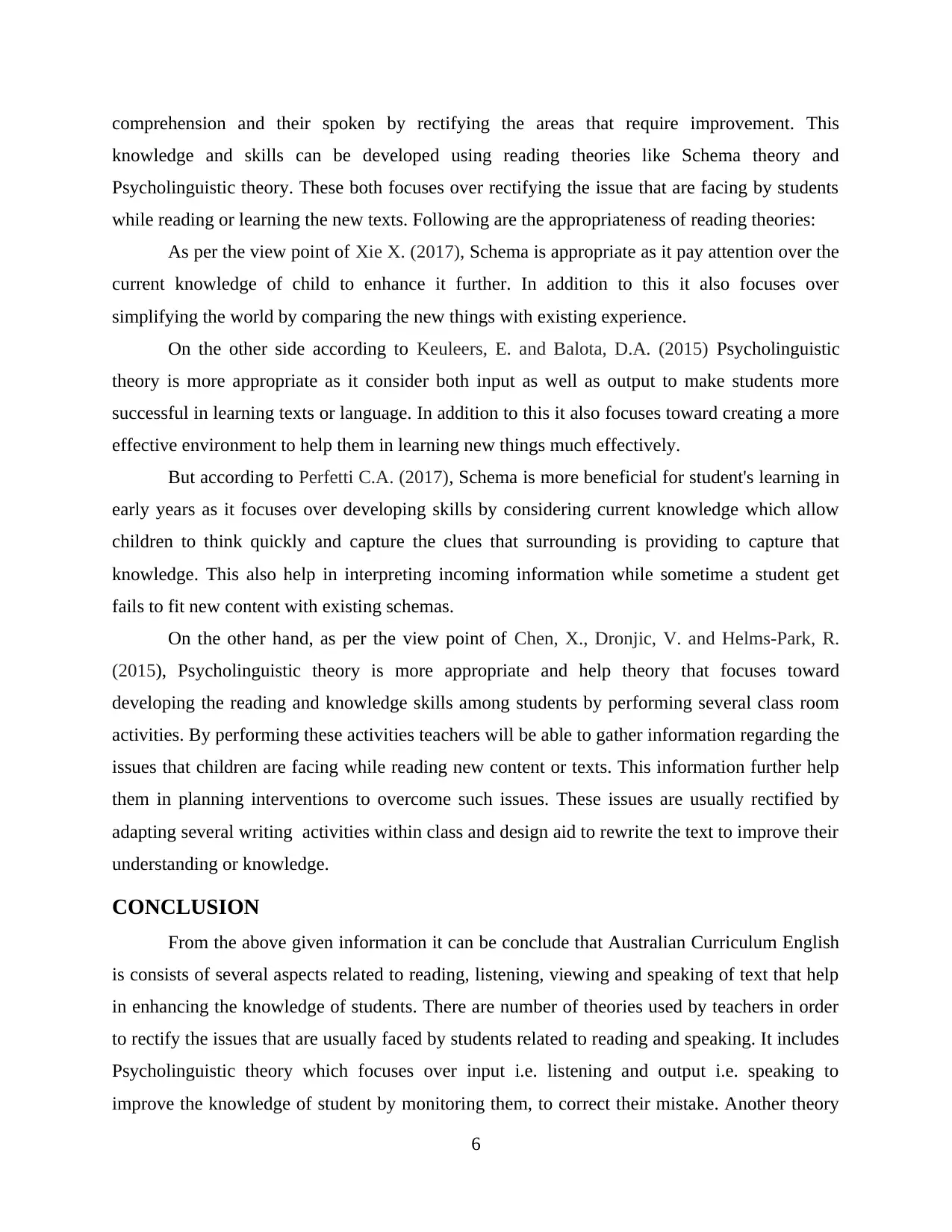
comprehension and their spoken by rectifying the areas that require improvement. This
knowledge and skills can be developed using reading theories like Schema theory and
Psycholinguistic theory. These both focuses over rectifying the issue that are facing by students
while reading or learning the new texts. Following are the appropriateness of reading theories:
As per the view point of Xie X. (2017), Schema is appropriate as it pay attention over the
current knowledge of child to enhance it further. In addition to this it also focuses over
simplifying the world by comparing the new things with existing experience.
On the other side according to Keuleers, E. and Balota, D.A. (2015) Psycholinguistic
theory is more appropriate as it consider both input as well as output to make students more
successful in learning texts or language. In addition to this it also focuses toward creating a more
effective environment to help them in learning new things much effectively.
But according to Perfetti C.A. (2017), Schema is more beneficial for student's learning in
early years as it focuses over developing skills by considering current knowledge which allow
children to think quickly and capture the clues that surrounding is providing to capture that
knowledge. This also help in interpreting incoming information while sometime a student get
fails to fit new content with existing schemas.
On the other hand, as per the view point of Chen, X., Dronjic, V. and Helms-Park, R.
(2015), Psycholinguistic theory is more appropriate and help theory that focuses toward
developing the reading and knowledge skills among students by performing several class room
activities. By performing these activities teachers will be able to gather information regarding the
issues that children are facing while reading new content or texts. This information further help
them in planning interventions to overcome such issues. These issues are usually rectified by
adapting several writing activities within class and design aid to rewrite the text to improve their
understanding or knowledge.
CONCLUSION
From the above given information it can be conclude that Australian Curriculum English
is consists of several aspects related to reading, listening, viewing and speaking of text that help
in enhancing the knowledge of students. There are number of theories used by teachers in order
to rectify the issues that are usually faced by students related to reading and speaking. It includes
Psycholinguistic theory which focuses over input i.e. listening and output i.e. speaking to
improve the knowledge of student by monitoring them, to correct their mistake. Another theory
6
knowledge and skills can be developed using reading theories like Schema theory and
Psycholinguistic theory. These both focuses over rectifying the issue that are facing by students
while reading or learning the new texts. Following are the appropriateness of reading theories:
As per the view point of Xie X. (2017), Schema is appropriate as it pay attention over the
current knowledge of child to enhance it further. In addition to this it also focuses over
simplifying the world by comparing the new things with existing experience.
On the other side according to Keuleers, E. and Balota, D.A. (2015) Psycholinguistic
theory is more appropriate as it consider both input as well as output to make students more
successful in learning texts or language. In addition to this it also focuses toward creating a more
effective environment to help them in learning new things much effectively.
But according to Perfetti C.A. (2017), Schema is more beneficial for student's learning in
early years as it focuses over developing skills by considering current knowledge which allow
children to think quickly and capture the clues that surrounding is providing to capture that
knowledge. This also help in interpreting incoming information while sometime a student get
fails to fit new content with existing schemas.
On the other hand, as per the view point of Chen, X., Dronjic, V. and Helms-Park, R.
(2015), Psycholinguistic theory is more appropriate and help theory that focuses toward
developing the reading and knowledge skills among students by performing several class room
activities. By performing these activities teachers will be able to gather information regarding the
issues that children are facing while reading new content or texts. This information further help
them in planning interventions to overcome such issues. These issues are usually rectified by
adapting several writing activities within class and design aid to rewrite the text to improve their
understanding or knowledge.
CONCLUSION
From the above given information it can be conclude that Australian Curriculum English
is consists of several aspects related to reading, listening, viewing and speaking of text that help
in enhancing the knowledge of students. There are number of theories used by teachers in order
to rectify the issues that are usually faced by students related to reading and speaking. It includes
Psycholinguistic theory which focuses over input i.e. listening and output i.e. speaking to
improve the knowledge of student by monitoring them, to correct their mistake. Another theory
6
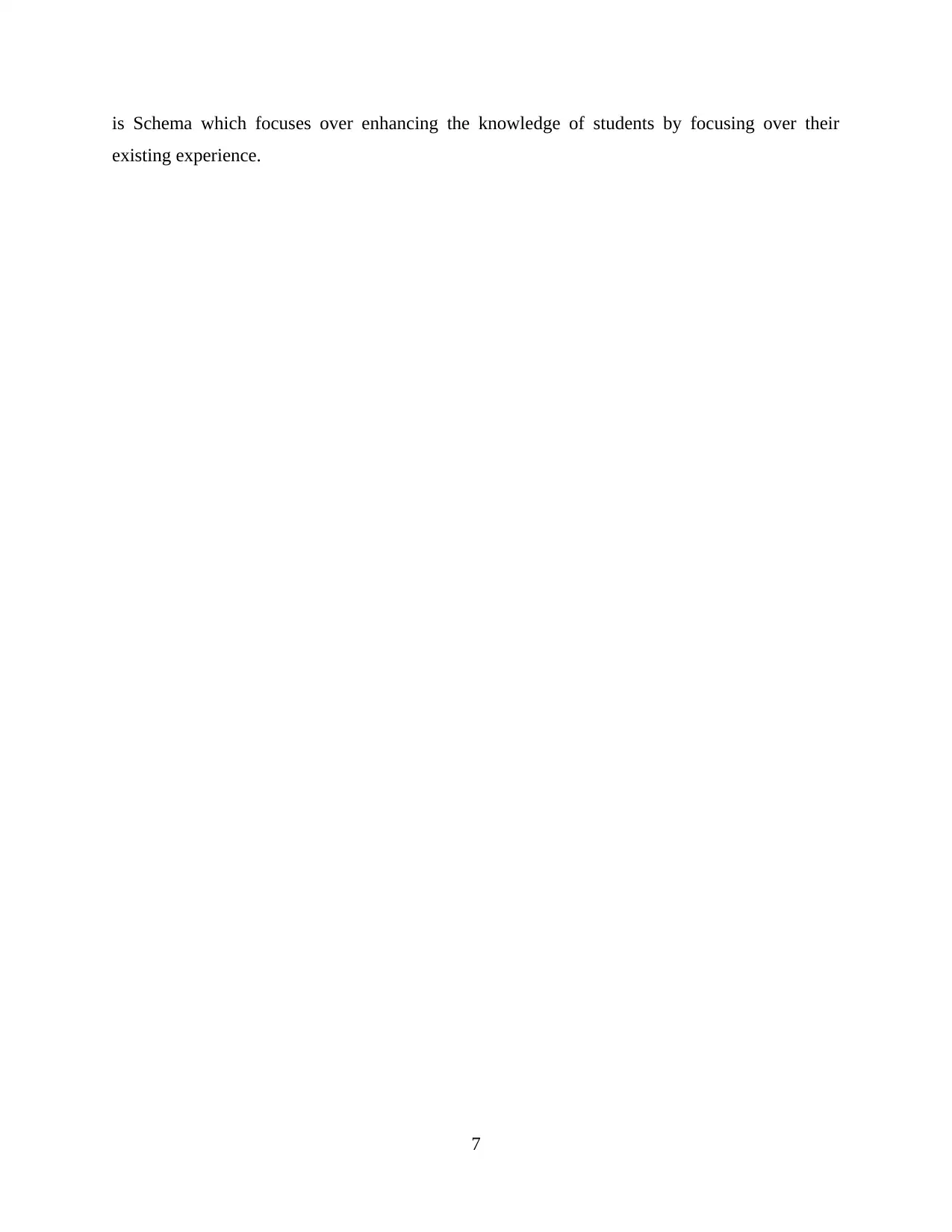
is Schema which focuses over enhancing the knowledge of students by focusing over their
existing experience.
7
existing experience.
7
⊘ This is a preview!⊘
Do you want full access?
Subscribe today to unlock all pages.

Trusted by 1+ million students worldwide
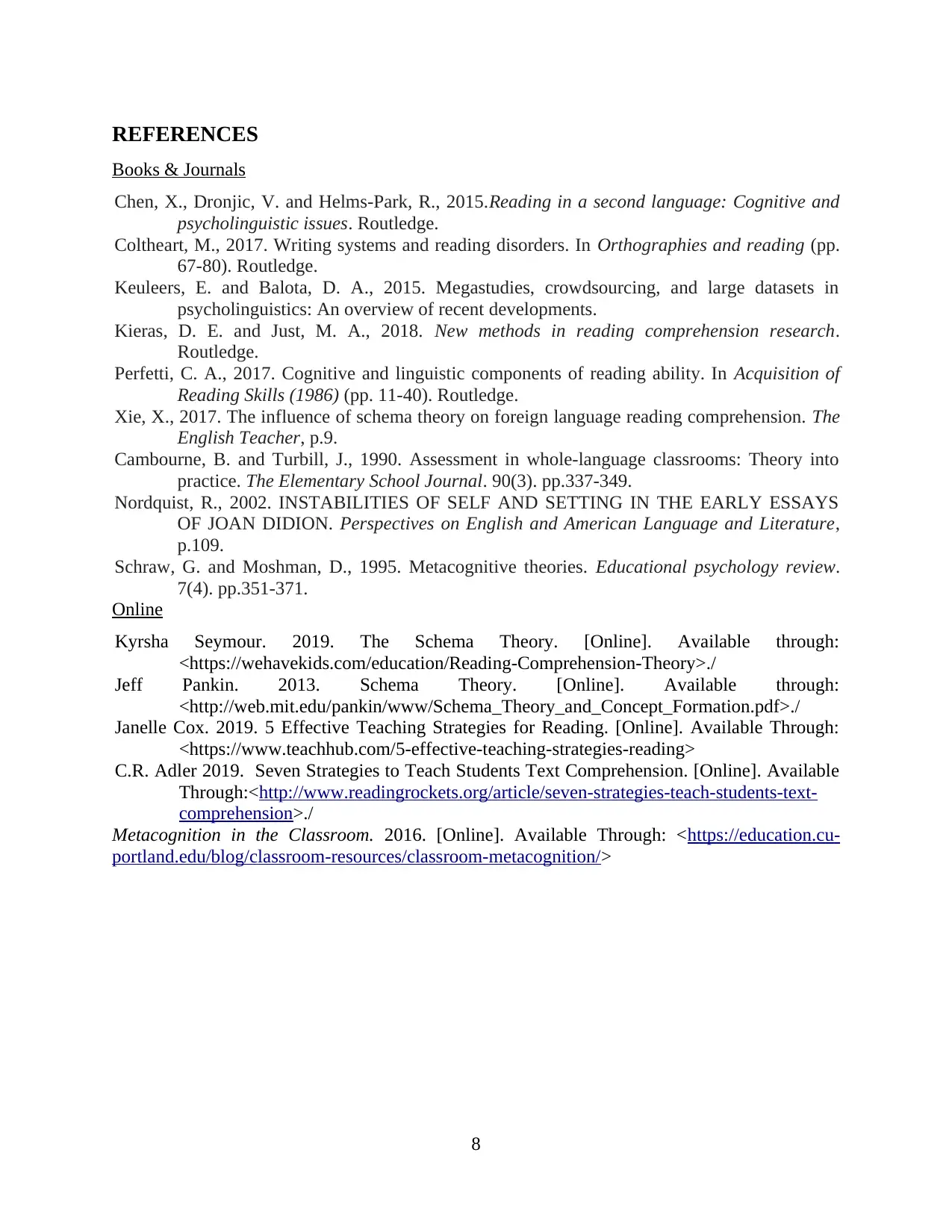
REFERENCES
Books & Journals
Chen, X., Dronjic, V. and Helms-Park, R., 2015.Reading in a second language: Cognitive and
psycholinguistic issues. Routledge.
Coltheart, M., 2017. Writing systems and reading disorders. In Orthographies and reading (pp.
67-80). Routledge.
Keuleers, E. and Balota, D. A., 2015. Megastudies, crowdsourcing, and large datasets in
psycholinguistics: An overview of recent developments.
Kieras, D. E. and Just, M. A., 2018. New methods in reading comprehension research.
Routledge.
Perfetti, C. A., 2017. Cognitive and linguistic components of reading ability. In Acquisition of
Reading Skills (1986) (pp. 11-40). Routledge.
Xie, X., 2017. The influence of schema theory on foreign language reading comprehension. The
English Teacher, p.9.
Cambourne, B. and Turbill, J., 1990. Assessment in whole-language classrooms: Theory into
practice. The Elementary School Journal. 90(3). pp.337-349.
Nordquist, R., 2002. INSTABILITIES OF SELF AND SETTING IN THE EARLY ESSAYS
OF JOAN DIDION. Perspectives on English and American Language and Literature,
p.109.
Schraw, G. and Moshman, D., 1995. Metacognitive theories. Educational psychology review.
7(4). pp.351-371.
Online
Kyrsha Seymour. 2019. The Schema Theory. [Online]. Available through:
<https://wehavekids.com/education/Reading-Comprehension-Theory>./
Jeff Pankin. 2013. Schema Theory. [Online]. Available through:
<http://web.mit.edu/pankin/www/Schema_Theory_and_Concept_Formation.pdf>./
Janelle Cox. 2019. 5 Effective Teaching Strategies for Reading. [Online]. Available Through:
<https://www.teachhub.com/5-effective-teaching-strategies-reading>
C.R. Adler 2019. Seven Strategies to Teach Students Text Comprehension. [Online]. Available
Through:<http://www.readingrockets.org/article/seven-strategies-teach-students-text-
comprehension>./
Metacognition in the Classroom. 2016. [Online]. Available Through: <https://education.cu-
portland.edu/blog/classroom-resources/classroom-metacognition/>
8
Books & Journals
Chen, X., Dronjic, V. and Helms-Park, R., 2015.Reading in a second language: Cognitive and
psycholinguistic issues. Routledge.
Coltheart, M., 2017. Writing systems and reading disorders. In Orthographies and reading (pp.
67-80). Routledge.
Keuleers, E. and Balota, D. A., 2015. Megastudies, crowdsourcing, and large datasets in
psycholinguistics: An overview of recent developments.
Kieras, D. E. and Just, M. A., 2018. New methods in reading comprehension research.
Routledge.
Perfetti, C. A., 2017. Cognitive and linguistic components of reading ability. In Acquisition of
Reading Skills (1986) (pp. 11-40). Routledge.
Xie, X., 2017. The influence of schema theory on foreign language reading comprehension. The
English Teacher, p.9.
Cambourne, B. and Turbill, J., 1990. Assessment in whole-language classrooms: Theory into
practice. The Elementary School Journal. 90(3). pp.337-349.
Nordquist, R., 2002. INSTABILITIES OF SELF AND SETTING IN THE EARLY ESSAYS
OF JOAN DIDION. Perspectives on English and American Language and Literature,
p.109.
Schraw, G. and Moshman, D., 1995. Metacognitive theories. Educational psychology review.
7(4). pp.351-371.
Online
Kyrsha Seymour. 2019. The Schema Theory. [Online]. Available through:
<https://wehavekids.com/education/Reading-Comprehension-Theory>./
Jeff Pankin. 2013. Schema Theory. [Online]. Available through:
<http://web.mit.edu/pankin/www/Schema_Theory_and_Concept_Formation.pdf>./
Janelle Cox. 2019. 5 Effective Teaching Strategies for Reading. [Online]. Available Through:
<https://www.teachhub.com/5-effective-teaching-strategies-reading>
C.R. Adler 2019. Seven Strategies to Teach Students Text Comprehension. [Online]. Available
Through:<http://www.readingrockets.org/article/seven-strategies-teach-students-text-
comprehension>./
Metacognition in the Classroom. 2016. [Online]. Available Through: <https://education.cu-
portland.edu/blog/classroom-resources/classroom-metacognition/>
8
1 out of 10
Related Documents
Your All-in-One AI-Powered Toolkit for Academic Success.
+13062052269
info@desklib.com
Available 24*7 on WhatsApp / Email
![[object Object]](/_next/static/media/star-bottom.7253800d.svg)
Unlock your academic potential
Copyright © 2020–2025 A2Z Services. All Rights Reserved. Developed and managed by ZUCOL.





